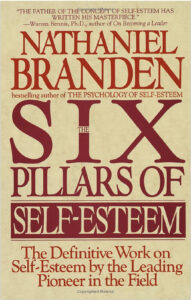
The Six Pillars of Self-Esteem is a seminal work by psychologist Dr. Nathaniel Branden. The book delves into the concept of self-esteem, its importance, and how one can cultivate it. Here’s an in-depth summary of the book:
Dr. Branden introduces self-esteem as a basic human need that is essential for survival and normal, healthy personal development. He posits that self-esteem has two interrelated components:
- Self-efficacy: Confidence in our ability to think, learn, choose, and make appropriate decisions.
- Self-respect: Confidence in our right to be happy and in deserving respect.
Contents
The Six Pillars
At the heart of the book, Branden dives deep into six pivotal practices, each shedding light on the intricate journey of building and nurturing self-esteem. Let’s break them down:
- The Practice of Living Consciously
Dive into the present moment. It’s about truly immersing yourself in your surroundings, being in tune with your actions, and genuinely feeling your emotions. More than just being aware, it’s about embracing the world as it is and taking ownership of the choices you make. - The Practice of Self-Acceptance
Branden passionately drives home a simple truth: accept yourself, warts and all. It’s not about turning a blind eye to your imperfections. Instead, it’s recognizing them and not beating yourself up over them. - The Practice of Self-Responsibility
Own your actions. Own your dreams. It’s the realization that you’re the captain of your ship, making choices and steering your life’s direction. - The Practice of Self-Assertiveness
Value yourself. Whether it’s your needs, desires, or core values, don’t shy away from expressing them. It’s a call to be genuine, to be you, and to stand tall in your truth. - The Practice of Living Purposefully
Have a roadmap for your life. It’s about pinpointing what you want, both in the immediate future and the long haul, and charting out the steps to get there. It’s a blend of vision and meticulous planning. - The Practice of Personal Integrity
Walk your talk. Align your actions with your core beliefs and values. For Branden, integrity isn’t just a word; it’s the harmonious blend of your ideals, convictions, and actions.
The Impact of Self-Esteem
Branden discusses how self-esteem, or the lack thereof, can influence various areas of one’s life, including:
- Relationships: People with higher self-esteem can establish more fulfilling and healthier relationships.
- Work: They are likely to be more ambitious, resilient, and innovative.
- Health: Higher self-esteem can lead to better mental and physical health.
Nurturing Self-Esteem in Children
The book also touches upon the role of parents, teachers, and society in nurturing a child’s self-esteem. Branden emphasizes the importance of conscious parenting, setting appropriate boundaries, and offering genuine praise.
Criticism
This is a seminal book on the subject of self-esteem, but it’s also a reflection of the time it was written in, and the personal beliefs and ideas of Nathanial Branden. As such, it’s worth pointing out some potential counterpoints:
- Overemphasis on Individualism: From my perspective, Branden’s lens on self-esteem seems to heavily tilt towards individualism and the power of self-reliance. This focus, while valuable, risks overshadowing the profound role of community bonds, nurturing relationships, and the healing touch of external support in our journey to self-worth.
- Nature vs. Nurture Debate: While Branden champions the transformative power of personal practices in shaping self-esteem, we mustn’t forget the deep-seated influences of our genetic makeup and the imprints of early childhood. These foundational elements often cast a longer shadow on our sense of self than any habits we adopt later in life.
- Potential for Narcissism: A word of caution: an overzealous pursuit of self-esteem can sometimes veer into the treacherous waters of narcissism. It’s crucial to discern true self-worth from the seductive allure of self-centeredness or inflated self-esteem.
- Cultural Bias: The six pillars, as Branden presents them, seem to echo the ethos of Western individualism. But let’s remember, in many cultures around the world, the tapestry of self-worth is woven with threads of community and relational values, challenging the universality of Branden’s approach.
- Over-simplification: The six pillars, while offering a structured path, might not capture the intricate dance of human psychology in its entirety. To distill the vast realm of self-worth into just six practices might be missing some of the nuanced steps.
- Economic and Social Factors: One can’t help but wonder if Branden has given due consideration to the socio-economic landscapes that shape our lives. The challenges of poverty, the scars of discrimination, or the weight of systemic oppression can profoundly influence one’s ability to embrace these pillars, especially when compared to those cushioned by privilege.
- Validity of Self-Reported Self-Esteem: A lingering question in the corridors of psychology is the trustworthiness of self-assessed self-esteem. There’s a genuine concern that we, as individuals, might either amplify or diminish our self-worth, muddying the waters of authentic self-perception.
In response to these critiques, proponents of Branden’s approach argue that the six pillars provide a practical framework for individuals to take proactive steps in enhancing their self-worth. While external factors and early experiences play a role, the emphasis on personal responsibility empowers individuals to take charge of their self-esteem journey.
Conclusion
Dr. Branden concludes by reiterating the importance of self-esteem in leading a fulfilling, purposeful, and joyful life. He stresses that while the journey to cultivating self-esteem is continuous and challenging, the rewards are invaluable.
“The Six Pillars of Self-Esteem” is not just a theoretical exploration but also offers practical insights and exercises to help readers integrate these principles into their daily lives. It’s a guide which lay a foundation for anyone looking to enhance their self-worth and lead a more empowered life. If you are however someone who wants to improve their self-esteem, this book wouldn’t be our first recommendation.
